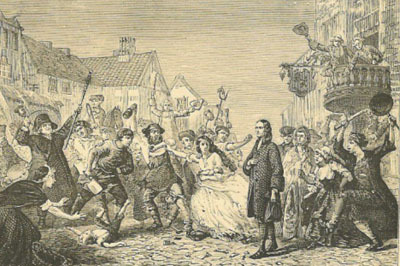
Neuroimaging 'will to fight' for sacred values: an empirical case study with supporters of an AQ associate (2018); Nafees Hamid et al. Research spokesperson: Scott Atran, an adjunct research professor at the University of Michigan’s Ford School and Institute for Social Research
Sacred values are preferences, beliefs and practices that communities deem protected from material trade-offs
Self-reporting of support for violence appears insensitive to material costs and benefits, and asking people to trade sacred values for material benefits provokes moral outrage.
This feature of intergroup conflict, where people fight on when odds of victory are low, suggests choices made independently of calculated risks and likely outcomes. If so, then a primary focus on undestanding, preventing or deterring such behaviors through utilitarian cost-imposition strategies may be insufficient.
Although behavioral work suggests willingness to fight and die for sacred values is relatively insensitive to cost-benefit reasoning, it may be possible to modulate it using methods that do not entail material incentives or threats.
Research on radicalization distinguishes between deradicalization and disengagement, suggesting that former violent extremists rarely change their beliefs (deradicalize) but more often lose their motivation to defent them (disengage). [32. Deradicalization or Disengagement? A process in need of clarity ...; J. Horgan (Perspect. Terror. 2. 3-8)] Accordingly, we conjectured that it might be possible to induce flexibility in the way people defend their sacred values.
different decision pathways
distinguish radicalized from non-radicalized individuals (an important, but different, research topic).
Willingness to fight and die ratings were substantially higher for sacred values (mean 6.61 out of 7 points) than for non-sacred values (mean 3.8). Willingness to fight and die ratings were also conveyed faster in trials comprising sacred values (4.72 vs 5.49)... Value sacredness was stable after six months.
the sacred value condition... involved less activation in neural areas previously associated with cognitive control and utilitarian reasoning.
For both sacred and non-sacred values there was a significant change in willingness to fight and die ratings in the direction established by peers after participants received conflicting (peers-lower) community feedback, with no statistical interaction with value sacredness. In addition, the sacred values condition evoked higher degrees of both moral outrage (built as an average of anger, contempt, an disgust scores) and joy at peers' willingness to fight and die ratings compared with the non-sacred value condition. Post manipulation moral outrage ratings were substantially higher... when values were sacred...
This observation is consistent with the role of the insula in social aversion, including reactions of disgust and indignation.
Nevertheless, the moderating effect of social influence on willingness to fight and die was independent of moral outrage, suggesting that social influence may affect committment to willingness to fight and die in an implicit way.
Overall, these observations are consistent with the idea that choices involving sacred values are less dependent on cost-benefit calculations than choices involving non-sacred values, and the view of sacred values as moral imperatives guiding goal-oriented actions.
deep-seated political conflicts, such as the Israeli-Palestinian conclict, the Iranian nuclear programme, the Muslim-Hindu conlict...
Figuring out the neural mechanisms that sustain sacred value processing will be key to: (i) validating behavioural modulation effects on value committment by factors that differentially affect sacred and non-sacred values, and (ii) comaring neural substrates of sacred value processing in different samples with diverse cultural backgrounds in order to define cross-cultural commonalities in sacred value processing.
The question remains why there were no brain regions associated with affective processing, such as the amygdala, which activated during the sacred compared with the non-sacred value condition. We believe that the most likely explanation for this owes to our experimental paradigm not being sensitive enough to detect the differential neural activity associated with affective regions.
decisions regarding sacred values may rely on deontic rights and wrongs, whereas decisions over non-sacred values may rely on cost-benefit ponderation.
a heuristic making decisions easy to solve, or cached-offline, whereas decisions regarding non-sacred values would involve some degree of calculation.
community feedback shifted willingness to fight and die ratings in the direction established by peers
Our findings suggest that even when social network interventions are unlikely to reduce commitment to a sacred value, they could reduce adherence to violent options.
FROM THE INTERVIEW
then material incentives (economic carrots) or disincentives (sanctions as sticks) only back re.
We found that the brain used di erent networks when considering di erent causes. There were areas we saw that were inhibited, silent, for sacred causes. These were the areas we call deliberative. These are involved in assessing the pros and cons. With sacred causes when people are deciding how much they should ght and die, they are deciding much faster. It’s not a rational decision, but a rapid duty-bound response regardless of real costs or likely consequences. They are doing what they believe.
Arguments and attempts at persuasion that rely on rational and seemingly reasonable attempts to pull people away also will have limited impact because the part of their brain associated with deliberative reasoning has deactivated. Moreover, such strategies do not reach out to the individual.
We also have to nd out when and why people lock in to sacred values, and how those values might be de-sacralized.
Another implication is that the people best poised to get others to abandon violence without abandoning values are those who hold the same values. This con rmed what I had previously observed in Sulawesi, when Sala preachers were able to dissuade a suicide attack group from killing others and dying themselves.
Comments: 0